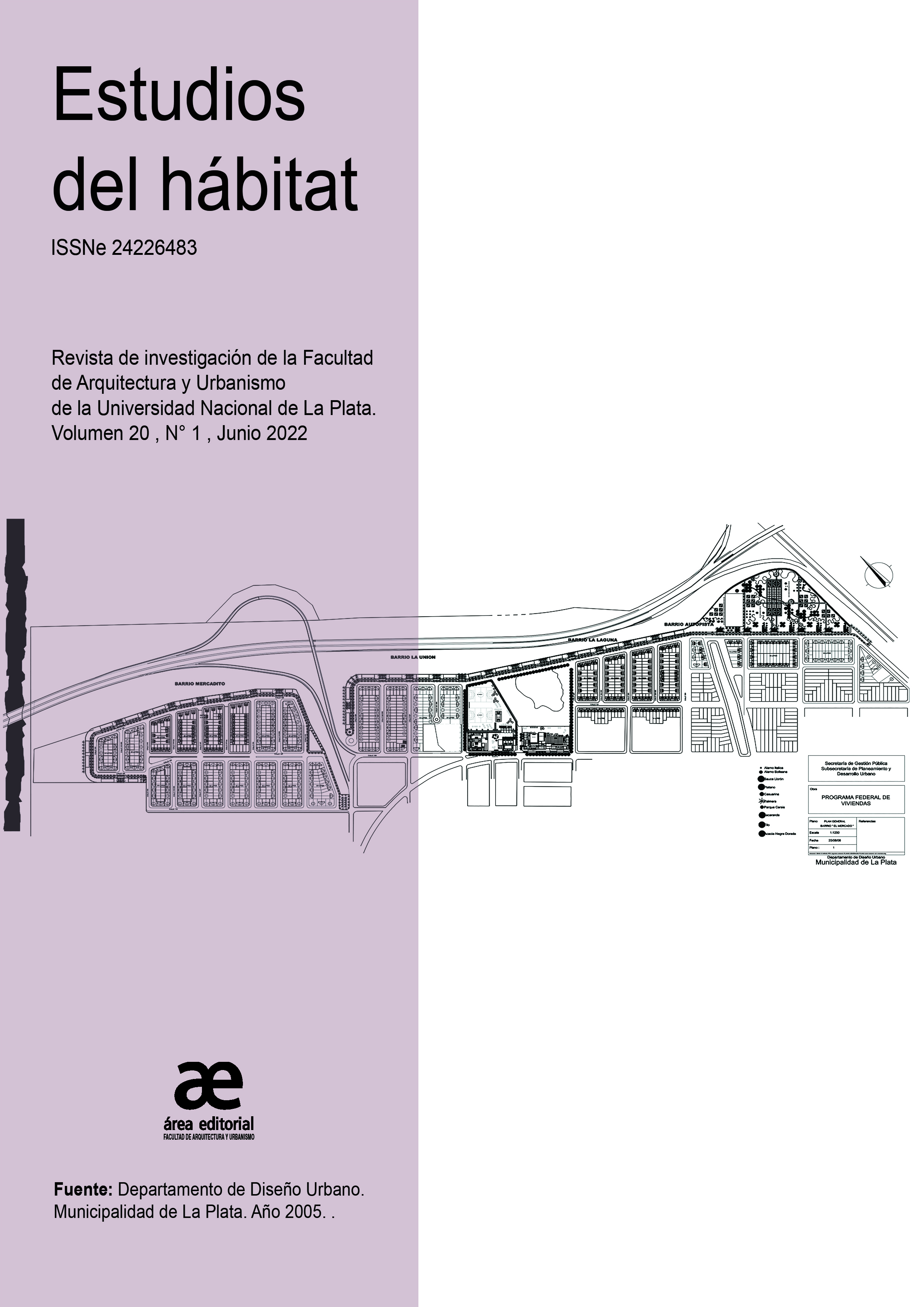Técnicas de construcción o edificación en vivienda: una revisión de la literatura
DOI:
https://doi.org/10.24215/24226483e112Palabras clave:
vivienda, istemas constructivos, evisión de literatura, albañilería, sistema constructivoResumen
Este estudio tiene como objetivo identificar las técnicas constructivas recurrentes utilizadas en los edificios de uso residencial. El procedimiento metodológico adoptado fue la revisión sistemática de la literatura con base en el diagrama de flujo Prisma 2020. Las búsquedas se realizaron en las siguientes plataformas de bases de datos: Google Scholar, Science Direct, Scopus y Web of Science. Los resultados mostraron un mapa de los procesos y materiales más utilizados, como albañilería con diferentes tipos de bloques, madera y estructuras metálicas. Los resultados presentados aquí proporcionan referencias bibliográficas para ayudar a investigadores y profesionales.
Referencias
Alavéz-Ramírez, R., Chiñas-Castillo, F., Morales-Domínguez, V. J., Ortiz-Guzmán, M., Caballero-Montes, J. L., & Caballero-Caballero, M. (2018). Thermal lag and decrement factor of constructive component reinforced mortar channels filled with soil–cement–sawdust. Indoor and Built Environment , 27(4). https://doi.org/10.1177/1420326X16676611
Alonso, P., & Palmarola, H. (2015). A panel’s trajectories. ARQ, 2015(90). https://doi.org/10.4067/S0717-69962015000200005
Argüello Méndez, T. del R., & Cuchí Burgos, A. (2008). Análisis del impacto ambiental asociado a los materiales de construcción empleados en las viviendas de bajo coste del programa 10 x10 Con Techo-Chiapas del CYTED. Informes de La Construcción, 60(509), 25–34. https://doi.org/10.3989/ic.2008.v60.i509.588
Bedoya-Montoya, C. M. (2018). Construcción de vivienda sostenible con bloques de suelo cemento: del residuo al material. Revista de Arquitectura , 20(1). https://doi.org/10.14718/revarq.2018.20.1.1193
Bonet Miró, A., & Brunelli, L. (2007). 198 “Low-cost housing†in Valdivia, X Region, Chile. Informes de La Construcción, 59(506). https://doi.org/10.3989/ic.2007.v59.i506.510 Braghieri, N. (2019). ‘The Towers of Terror’’: A Critical Analysis of Ernő Goldfinger’s Balfron and Trellick Towers. Urban Planning, 4(3). https://doi.org/10.17645/up.v4i3.2118
Brandao, R. P., Callejas, I. J. A., & Durante, L. C. (2019). Habitações vernaculares e de interesse social contemporâneas: investigação sobre a qualidade ambiental e sustentabilidade dos sistemas construtivos. Revista Geoaraguaia , 9(1). https://periodicoscientificos.ufmt.br/ojs/index.php/geo/article/view/7136
Brás, A., Gonçalves, F., & Faustino, P. (2014). Economic evaluation of the energy consumption and thermal passive performance of Portuguese dwellings. Energy and Buildings , 76. https://doi.org/10.1016/j.enbuild.2014.01.029
Brumaru, M., & Cobârzan, N. (2008). Concerns and trends in building energy efficient dwellings in Romania. International Journal for Housing Science and Its Applications, 32(4).
Campos, I. D. D., & Bernardo, L. F. A. (2020a). Architecture and steel prototype in steel structure with equal angles steel profiles, in Greek cross shape, applied in an architectural project. Designs , 4(3). https://doi.org/10.3390/designs4030024
Campos, I. D. D., & Bernardo, L. F. A. (2020b). Architecture and steel. Reflection and analysis on the use of steel structures (in sight) as a concept in the history of architecture. Designs , 4(3). https://doi.org/10.3390/designs4030030
Caparrós, P. J., & Astarloa, E. A. (2017). Arquitecturas reversibles de Japón. Las casas de Shirakawa-go. Revista Indexada de Textos Academicos, 7. https://doi.org/10.24192/2386-7027(2017)(v7)(04)
Caro, R., & Sendra, J. J. (2021). Are the dwellings of historic Mediterranean cities cold in winter? A field assessment on their indoor environment and energy performance. Energy and Buildings , 230. https://doi.org/10.1016/j.enbuild.2020.110567
Casagrande, D., Sinito, E., Izzi, M., Pasetto, G., & Polastri, A. (2021). Structural performance of a hybrid timber wall system for emergency housing facilities. Journal of Building Engineering, 33. https://doi.org/10.1016/j.jobe.2020.101566
Cobîrzan, N., Oltean-Dumbrava, C., & Brumaru, M. (2012). Thermal rehabilitation of Romanian housing: A low cost assessment tool. International Journal of Sustainable Engineering, 5(3). https://doi.org/10.1080/19397038.2011.637244
Cook, J. (1996). Architecture indigenous to extreme climates. Energy and Buildings , 23(3). https://doi.org/10.1016/0378-7788(95)00953-1
Damico, F. C., Alvarado, R. G., Kelly, M. T., Oyola, O. E., Oyola, O. E., & Diaz, M. (2012). Análisis energético de las viviendas del centro-sur de Chile. In Arquiteturarevista , 8(1). https://doi.org/10.4013/arq.2012.81.07
del Caz-Enjuto, M. R., Sáinz-Guerra, J. L., & Jové-Sandoval, F. (2019). Protohabitat: Research in a sustainable: Habitat in developing countries. A study case. Cuadernos de Vivienda y Urbanismo , 12(24). https://doi.org/10.11144/Javeriana.cvu12-24.pihs
Domínguez, S., Sendra, J. J., León, A. L., & Esquivias, P. M. (2012). Towards energy demand reduction in social housing buildings: Envelope system optimization strategies. Energies , 5(7). https://doi.org/10.3390/en5072263
Dutu, A., Gomes Ferreira, J., Guerreiro, L., Branco, F., & Gonçalves, A. M. (2012). Timbered masonry for earthquake resistance in Europe. In Materiales de Construccion, 62(308). https://doi.org/10.3989/mc.2012.01811
Ferrer Forés, J. J. (2017). Jørn Utzon. Cuaderno de Notas , 18. https://doi.org/10.20868/cn.2017.3601
Ferrer Forés, J. J. (2017). Knud Peter Harboe. Construcciones estrictas. Rita, 8(02). https://doi.org/10.24192/2386-7027(2017)(v8)(02)
Figueiredo, A., Kämpf, J., & Vicente, R. (2016). Passive house optimization for Portugal: Overheating evaluation and energy performance. In Energy and Buildings, 118. https://doi.org/10.1016/j.enbuild.2016.02.034
García, J. F. R. (2015). Antonio bonet y josep puig torné. Series triangulares en cap de salou. RA Revista de Arquitectura , 17. https://doi.org/10.15581/014.17.57-64
García, Y., Cuadrado, J., Blanco, J. M., & Roji, E. (2019). Optimizing the indoor thermal behaviour of housing units in hot humid climates: Analysis and modelling of sustainable constructive alternatives. Indoor and Built Environment , 28(6). https://doi.org/10.1177/1420326X18793965
García-Pérez, S., Sierra-Pérez, J., Boschmonart-Rives, J., Lladó Morales, G., & Romero Calix, A. (2017). A characterisation and evaluation of urban areas from an energy efficiency approach, using geographic information systems in combination with life cycle assessment methodology. International Journal of Sustainable Development and Planning , 12(2). https://doi.org/10.2495/SDP-V12-N2-294-303
González Mahecha, R. E., Rosse Caldas, L., Garaffa, R., Lucena, A. F. P., Szklo, A., & Toledo Filho, R. D. (2020). Constructive systems for social housing deployment in developing countries: A case study using dynamic life cycle carbon assessment and cost analysis in Brazil. Energy and Buildings , 227. https://doi.org/10.1016/j.enbuild.2020.110395
Gonzalez Stumpf, M. A., Kulakowski, M. P., Breitenbach, L. G., & Kirch, F. (2014). A case study about embodied energy in concrete and structural masonry buildings. Revista de La Construcción, 13(2). https://doi.org/10.4067/s0718-915x2014000200001
González-Redondo, E. (2019). Los primeros entramados de madera y muros de ‘doble hoja’: las posadas de Madrid (1669-1798). Informes de La Construcción, 71(556). https://doi.org/10.3989/ic.66687
Goossens, M., & Gomez-Meneses, J. E. (2015). Experimentaciones en vivienda estatal. La obra del instituto de crédito territorial en bogotá, 1964-1973. Revista INVI , 30(84). https://doi.org/10.4067/S0718-83582015000200005
International Energy Agency. (2020). Buildings: A source of enormous untapped efficiency potential. Analysis by Topic: Buildings . International Energy Agency.
Larrinaga, P., Garmendia, L., Piñero, I., & San-José, J. T. (2020). Flexural strengthening of low-grade reinforced concrete beams with compatible composite material: Steel Reinforced Grout (SRG). Construction and Building Materials, 235. https://doi.org/10.1016/j.conbuildmat.2019.117790
Luna-Tintos, J. F., Cobreros, C., Herrera-Limones, R., & López-Escamilla, A. (2020). “Methodology comparative analysis” in the solar decathlon competition: A proposed housing model based on a prefabricated structural system. Sustainability (Switzerland), 12(6). https://doi.org/10.3390/su12051882
Marvila, M. T., Azevedo, A. R. G., Alexandre, J., Zanelato, E. B., Azeredo, N. G., Simonassi, N. T., & Monteiro, S. N.(2019). Correlation between the properties of structural clay blocks obtained by destructive tests and Ultrasonic Pulse Tests. Journal of Building Engineering , 26. https://doi.org/10.1016/j.jobe.2019.100869
Masferrer, R. R., Pérez, F. J., Orus, X. E., & Pujadas, N. V. (2012). The architecture of scarcity: The low-cost housing of Sant Cugat de Salt in 1956. EGA Revista de Expresion Grafica Arquitectonica, 19(1). https://doi.org/10.4995/ega.2012.1378
Mendonça, P., Cruz, N., & Macieira, M. (2017). Environmental and economic cost analysis of housing in temperate climate using an innovative lightweight partitioning system. International Journal of Sustainable Energy, 36(2). https://doi.org/10.1080/14786451.2015.1007140
Miličić, I. M., Folić, R. J., Prokić, A. D., & Čeh, A. A. (2019). Model for the analysis of thermal conductivity of composite material of natural origin. Thermal Science , 23. https://doi.org/10.2298/TSCI181215267M
Morganti, R., & Tosone, A. (2008). Buildings for housing: Steel technologies in the twentieth century. International Journal for Housing Science and Its Applications , 32(2).
Morganti, R., & Tosone, A. (2010). Building for housing: Steel technologies. International Journal for Housing Science and Its Applications , 34(2).
Navarro, L., de Gracia, A., Castell, A., Álvarez, S., & Cabeza, L. F. (2015). PCM incorporation in a concrete core slab as a thermal storage and supply system: Proof of concept. Energy and Buildings , 103. https://doi.org/10.1016/j.enbuild.2015.06.028
Orta, B., Adell, J., Bustamante, R., & Martínez-Cuevas, S. (2016). Sistema de autoconstrucción sismorresistente: Características resistentes y proceso constructivo. Informes de La Construccion , 68(542). https://doi.org/10.3989/ic.15.082
Page, M. J., McKenzie, J. E., Bossuyt, P. M., Boutron, I., Hoffmann, T. C., Mulrow, C. D., Shamseer, L., Tetzlaff, J. M., Akl, E. A., Brennan, S. E., Chou, R., Glanville, J., Grimshaw, J. M., Hróbjartsson, A., Lalu, M. M., Li, T., Loder, E. W., Mayo-Wilson, E., McDonald, S., … Moher, D. (2021). The PRISMA 2020 statement: An updated guideline for reporting systematic reviews. In The BM J, 372. https://doi.org/10.1136/bmj.n71
Pich-Aguilera, F., Batlle, T., & Casaldàliga, P. (2008). La arquitectura residencial como una realidad industrial. Tres ejemplos recientes. Informes de La Construccion , 60(512). https://doi.org/10.3989/ic.08.040
Prado García, F., & Illanes Garat, V. (2008). PROYECTO TARAPACÁ. Por la recuperación de poblados patrimoniales en el norte de Chile. Revista de La Construcción , 7(1).
Rodrigues, F., Matos, R., di Prizio, M., & Costa, A. (2018). Conservation level of residential buildings: Methodology evolution. Construction and Building Materials , 172. https://doi.org/10.1016/j.conbuildmat.2018.03.129
Rodrigues, L., & Gillott, M. (2013). Building for future climate resilience: A comparative study of the thermal performance of eight constructive methods. Smart Innovation, Systems and Technologies , 22. https://doi.org/10.1007/978-3-642-36645-1_43
Rosas Meza, I. (2009). La cultura constructiva informal y la transformación de los barrios caraqueños. Bitacora Urbano Territorial , 15(2).
Rosse Caldas, L., Bernstad Saraiva, A., Andreola, V. M., & Dias Toledo Filho, R. (2020). Bamboo bio-concrete as an alternative for buildings’ climate change mitigation and adaptation. Construction and Building Materials, 263. https://doi.org/10.1016/j.conbuildmat.2020.120652
Rossi, B., Marique, A. F., & Reiter, S. (2012). Life-cycle assessment of residential buildings in three different European locations, case study. Building and Environment, 51. https://doi.org/10.1016/j.buildenv.2011.11.002
Safapour, E., Kermanshachi, S., Alfasi, B., & Akhavian, R. (2019). Identification of schedule-performance indicators and Delay-Recovery strategies for low-cost housing projects. Sustainability (Switzerland), 11(21) https://doi.org/10.3390/su11216005
Salas, C. G. (2020). Ignacio Álvarez Castelao: Housing developments for power station workers. VLC Arquitectura , 7(2). https://doi.org/10.4995/vlc.2020.11354
Silva, A. S., Almeida, L. S. S., & Ghisi, E. (2016). Decision-making process for improving thermal and energy performance of residential buildings: A case study of constructive systems in Brazil. Energy and Buildings , 128. https://doi.org/10.1016/j.enbuild.2016.06.084
Silva, L. G. Z., & Sperandio, D. (2018). Sustentabilidade na construção civil: comparativo de custos entre o sistema de alvenaria convencional e wood frame como forma de redução do déficit habitacional no município de frederico westphalen - rs. Revista Gedecon. Revista Gestão e Desenvolvimento Em Contexto, 6(1). https://revistaeletronica.unicruz.edu.br/index.php/gedecon/article/download/133/76 /424
Skewes, J. C. (2016). Residencias en la cordillera: la lógica del habitar en los territorios mapuche del bosque templado lluvioso en Chile. Antípoda. Revista de Antropología y Arqueología, 26. https://doi.org/10.7440/antipoda26.2016.06
Soriano, F. M., Pericot, N. G., & Sierra, E. M. (2016). Comparative analysis of the reinforcement of a traditional wood floor in collective housing. In depth development with cross laminated timber and concrete. Case Studies in Construction Materials, 4. https://doi.org/10.1016/j.cscm.2016.03.004
Soutullo, S., Giancola, E., Jiménez, M. J., Ferrer, J. A., & Sánchez, M. N. (2020). How climate trends impact on the thermal performance of a typical residential building in Madrid. Energies , 13(1). https://doi.org/10.3390/en13010237
Torres-Dorado, S. M., & Añón-Abajas, R. M. (2019). BGB and BSC Systems (1949-56). The prefabricated dwellings of Antonio Bonet. In VLC Arquitectura, 6(1). https://doi.org/10.4995/vlc.2019.8982
Wu, P. I., Chen, Y., & Liou, J. L. (2021). Housing property along riverbanks in Taipei, Taiwan: a spatial quantile modelling of landscape benefits and flooding losses. Environment, Development and Sustainability, 23(2).
https://doi.org/10.1007/s10668-020-00680-7
Zhang, X., Shen, L., & Wu, Y. (2011). Green strategy for gaining competitive advantage in housing development: A China study. Journal of Cleaner Production, 19(2–3). https://doi.org/10.1016/j.jclepro.2010.08.005
Descargas
Publicado
Número
Sección
Licencia
Derechos de autor 2023 PhD Maria Augusta Justi Pisani, PhD Natacha Viana Seabra de Freitas, PhD Isabella Silva de Serro Azul

Esta obra está bajo una licencia internacional Creative Commons Atribución-NoComercial-SinDerivadas 4.0.
Acorde a estos términos, el material se puede compartir (copiar y redistribuir en cualquier medio o formato) y adaptar (remezclar, transformar y crear a partir del material otra obra), siempre que a) se cite la autoría y la fuente original de su publicación (revista y URL de la obra), b) no se use para fines comerciales y c) se mantengan los mismos términos de la licencia.








.jpg)

















